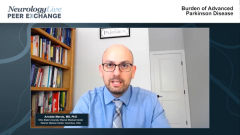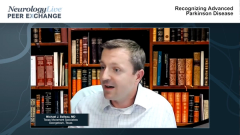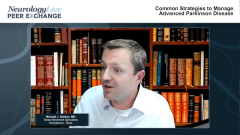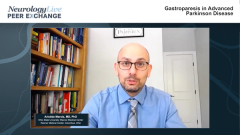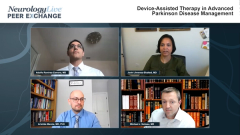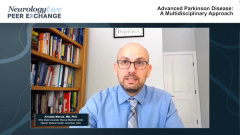
Device-Assisted Therapy in Advanced Parkinson Disease Management
A discussion about when a clinician should consider discussing a device-assisted therapy with a patient with advanced Parkinson disease.
Episodes in this series

Adolfo Ramirez-Zamora, MD: Let me move on to the next step in the discussion. We’ve already established that we care about patients’ quality of life. The treatment needs to be individualized. There are specific medications that apply for patients, depending on their needs and their goals. But now the patients are having motor fluctuations, so they’re becoming difficult to manage. We tried extended-release levodopa. Then we tried combination therapy, judicious polypharmacy. We added medications to increase wearing on, and then we added amantadine. And despite all that, patients continue to have trouble.
When should a clinician consider, or when should we start discussing device-assisted therapies with patients? When is the right time? There was a time not too long ago when patients were being referred only if nothing else would work, basically 25 years into their disease, when other non-motor symptoms were the leading source of disability. And then there are some reports saying that earlier is better, maybe as early as before you develop motor fluctuations. It may be confusing for some. When do we start talking about these therapies with patients? Joohi, would you mind talking? I’ll go over it, but please tell us a little bit about this.
Joohi Jimenez-Shahed, MD: Yes, we’ve talked a lot about education so far, and I do think that having a well-educated patient is definitely helpful in terms of being able to strategize for that individual patient. So I actually advocate for education about these devices right from the beginning, and I think it’s important for patients to know because a lot of them, as Michael was saying, have this perception of what might happen or what’s coming for them in the future, and they’re afraid of it. And I like to be able to give them the information up front that, “You know what, we will try and treat your symptoms with medications. We may run into certain problems, but if we feel like we’re not able to manage sufficiently with the oral medications, there are other more advanced therapies that are available for you. And those are things like deep brain stimulation or levodopa infusion.” I think there is a good opportunity to start that conversation almost up front. I’m not talking about a long, detailed discussion about when is going to be the right time or what we’re going to look for, but just to let them know that there are options when the medications are not working sufficiently.
Adolfo Ramirez-Zamora, MD: Michael, how about you, how do you incorporate this information into your practice, especially with somebody who’s just starting to have motor fluctuations? I typically tell patients that there’s clear evidence indicating that some of these advanced therapies are better than medications for patients that are having refractory motor fluctuations. When do you start talking about this?
Michael J. Soileau, MD: Same as Joohi, actually, first thing. I think it’s important. When someone is diagnosed with Parkinson, when we talk to them about all the different things that we have to treat Parkinson in this day and age, I find oftentimes they leave actually feeling hopeful, even with a brand new diagnosis of Parkinson. We really have to work hard at changing the stigma that’s associated with Parkinson disease. But even now, when I deliver the news of the new diagnosis of Parkinson disease, I am much more confident in my ability to treat Parkinson disease throughout the different gamuts than even 5 years ago. That’s how quickly things are changing for the better.
So I start talking about it first thing. And then, when do I actually initiate treatment? When these patients are having motor fluctuations and we’ve gone the route of optimizing their oral regimen, I like to break it into 2 categories. Is it something that’s happening more often than not? Do I find their background levodopa is fluctuating so much? Or is it something that happens every now and again for which a PRN medication perhaps can be useful, of which we have several to choose from now? If it’s something that’s happening all the time, then in my mind, it’s really important to start thinking about the different options that are available, whether that’s the brain stimulation like Joohi said, then carbidopa, levodopa infused in the duodenum, or new things that are coming out and currently in trials like subcutaneous levodopa and other infusions. I think what we’re realizing now is that the strategy of how these medicines are delivered to the brain is really critical.
Then to take that a step further, looking at evidence in trials to say—like you said earlier, Adolfo—well, what if instead of waiting until we have nothing else to do, we actually institute some of these things even earlier? Does it actually change when these patients develop their fluctuations? And I think that’s a very interesting concept, and we still need more data and more studies to determine that. But the bottom line is, we have plenty of things to do when the patient starts to have these fluctuations. The key is, number 1, not to be scared of them, because there are a lot of therapies that may be out of our comfort zone, and we can’t let that scare us. At the end of the day, we have to do whatever it takes to get that patient squared away. And then number 2 is to use our resources and advocate for these patients and make sure that we’re giving them whatever help they need by whatever means necessary. And I understand that movement disorder specialists are not on every corner in most areas of the country, so that’s why it’s important to have talks like this where we can let folks know about some of the newer things that are out to treat advancing Parkinson [disease]. I think it’s critical. That’s what I do.
Adolfo Ramirez-Zamora, MD: Thank you all for watching this Neurology Live® Peer Exchange. If you enjoyed the content, please subscribe to our e-newsletter to receive upcoming Peer Exchanges and other great content right in your in-box. Thank you so much.
Transcript Edited for Clarity
Newsletter
Keep your finger on the pulse of neurology—subscribe to NeurologyLive for expert interviews, new data, and breakthrough treatment updates.

